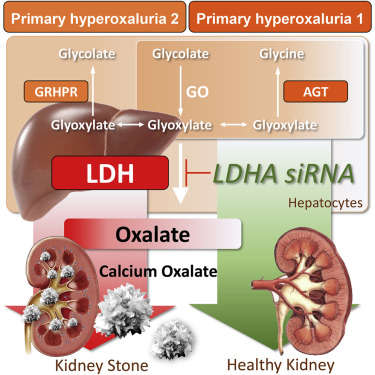DCR-PHXC
DCR-PHXC for Primary Hyperoxaluria (PH)
DCR-PHXC, as one of the RNA interference (RNAi) therapies, is a potential investigational short interfering RNA (siRNA) drug candidate for the treatment of all known PH forms. DCR-PHXC is conjugated to N-acetyl galactosamine based on the subcutaneously delivered GalXC technology and is utilized as the potential therapeutic candidate for patients with PH. PH is a severe, ultra-rare, genetic liver disorder that causes complications in the kidneys. Three known genetic types of PH result from the genetic mutation in different genes in the glyoxylate metabolism pathway, including AGXT, GRHPR, and HOGA1. These genetic mutations lead to the overproduction of oxalate substrate and further to result in the accumulation of a large amount of calcium oxalate crystals in the kidneys and other organs. It causes severe damage and complications to the kidneys, bone, skin, heart, blood, and eyes. Currently, there are no approved effective therapies for the PH diseases; combined liver-kidney transplant, which is often challenging to perform, is the only option for patients with PH. Thus, siRNA-based therapeutics such as DCR-PHXC are the potential novel treatment options for all three types of PH.
 Figure 1. The critical pathway of PH. (Lai, 2018)
Figure 1. The critical pathway of PH. (Lai, 2018)
Mechanism and Preclinical Study of DCR-PHXC
DCR-PHXC is designed for targeting the LDHA gene encoding Lactate Dehydrogenase (LDH) enzyme, which is directly involved in glyoxylate-to-oxalate conversion in the cytosol of liver hepatocytes. DCR-PHXC inhibits the LDH specifically in the liver and thus attempts to prevent the overproduction of oxalate. DCR-PHXC delivers subcutaneous to hepatocytes in the liver by conjugated to the GalNAc targeting ligands. GalNAc targeting ligands bind specifically to the Asialoglycoprotein receptors (ASGPR) on hepatic cell surfaces for yielding proprietary conjugate delivery configurations. This technology has several benefits, such as a high potency for the delivery of RNAi drugs, infrequent dosing, and a long duration of effective action.
In preclinical studies, DCR-PHXC blocks the production of excess oxalate and prevents the induced nephrocalcinosis symptoms in the mouse genetic model of PH1. In non-human primates, DCR-PHXC could mediate >90% silencing of the oxalate-generating enzyme LDHA by easily tolerated doses. In short, DCR-PHXC is shown to induce potent and long-term inhibition of LDH and to reduce levels of oxalate significantly while demonstrating long-term efficacy and tolerability in animal models of PH.
| Clinical Trial | Study | Conditions | Status |
| Phase 1 | Study of DCR-PHXC-101 in normal healthy volunteers and patients with primary hyperoxaluria | Primary Hyperoxaluria Type 1 and Type 2 | Completed |
| Phase 2 | A study to evaluate DCR-PHXC in children and adults with primary hyperoxaluria type 1 and primary hyperoxaluria type 2 (PHYOX2) | Primary Hyperoxaluria Type 1 and Type 2 | Recruiting |
| Phase 3 | Long term extension study in patients with primary hyperoxaluria (PHYOX 3) | Primary Hyperoxaluria Type 1, Type 2, and Type 3 | Enrolling by invitation |
DCR-PHXC into Clinical Trials
DCR-PHXC is tested in a Phase 1 trial, comprised of healthy volunteers and patients with PH types 1 and 2. The data shows post-dose reductions in 24-hour urinary oxalate levels in adult and adolescent study participants with PH1 and PH2. Urinary oxalate levels in a majority of participants are normalization or near-normalization after the treatment of DCR-PHXC with a single dose. The single dose of DCR-PHXC is favorable safety and well-tolerated for further clinical evaluation. DCR-PHXC phase 2 trial, which is a double-blind, randomized, placebo-controlled trial, is enrolling. Furthermore, DCR-PHXC phase 3 trial is a long-term, multi-dose, open-label, rollover extension trial designed to evaluate further the safety and efficacy of DCR-PHXC for all three types of PH. Based on all these clinical trials, it could expect that DCR-PHXC has the potential to be used as a novel option for patients with PH by silenced disease targets.
The data of DCR-PHXC in the clinical trials confirm that the siRNA-based therapeutics is an entirely new potential approach to mediate RNAi for targeting the cause of diseases in order to treat rare diseases. Creative Biolabs is a leading service provider in the field of RNAi therapies; our scientists can provide a wide range of siRNA-based drug research and development services, please feel free to contact us if you want more details.
Reference
- Lai, C.; et al. (2018). Specific inhibition of hepatic lactate dehydrogenase reduces oxalate production in mouse models of primary hyperoxaluria. Molecular Therapy. 26(8): 1983-1995.
